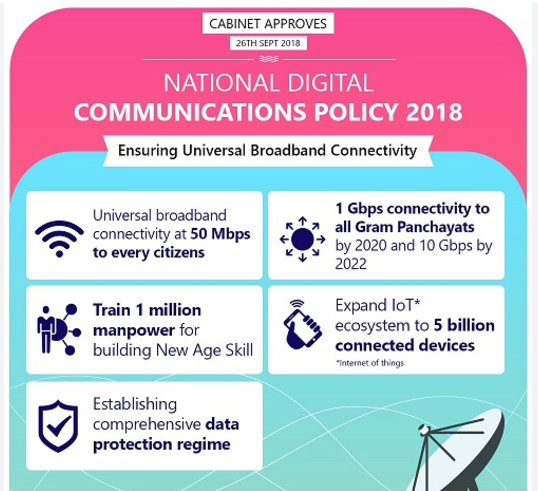5 December 2024 : PIB Summary For UPSC
1. NATIONAL DIGITAL COMMUNICATION POLICY, 2018
(Source – https://pib.gov.in/PressReleseDetail.aspx?PRID=2080648®=3&lang=1 )
| Topic: GS2 – Governance – Government Policies |
| Context |
|

| Key Improvements (2018–2024) |
|
Optical Fiber Network Expansion: Increased from 17.5 lakh km (March 2018) to 41.9 lakh km (October 2024). Base Transceiver Stations (BTS): Grew from 19.8 lakh (2018) to 29.4 lakh (2024). Mobile Connectivity: 6,22,840 of 6,44,131 villages have mobile connectivity as of September 2024. Broadband Subscribers: Doubled from 48 crore (2018) to 94 crore (2024). Data Usage: Increased from 8.32 GB/month (2018) to 21.30 GB/month (2024). Data Tariffs: Reduced from ₹10.91/GB (2018) to ₹8.31/GB (2024). |
Government Initiatives
- BharatNet Program: ₹1,39,579 crore allocated to connect 2.64 lakh Gram Panchayats and approximately 3.8 lakh villages.
- Digital Bharat Nidhi: Provides telecom coverage to uncovered villages.
Satellite Communication Reforms-2022
- Simplified regulations and reduced financial charges for licensees.
- Enabled non-government participation in satellite-based services, connecting 5,474 Gram Panchayats.
Spectrum Management Reforms
- Spectrum auctions since September 2021 allow surrender after 10 years, with no usage charges.
- Encourages spectrum sharing without additional charges, enhancing utilization efficiency.
- Spectrum refarming carried out for 5G services, with a clear assignment methodology outlined in the Telecommunications Act, 2023.
Role of TRAI
- TRAI ensures competition in the telecom sector by issuing regulations to maintain a multi-operator, competitive market.
| Practice Question: Discuss the impact of the National Digital Communication Policy, 2018 on India’s telecom infrastructure and digital empowerment. Highlight the role of government initiatives in promoting connectivity and affordability.(250 Words /15 marks) |



